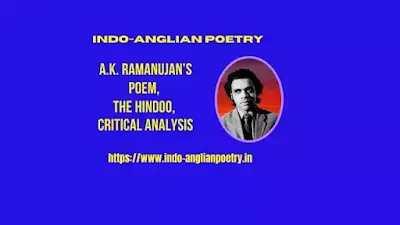Introduction of poem
This poem is an ironic exposure of a Hindoo's (the word “Hindu” has sometimes been spelt as Hindu and sometimes as Hindoo) supposed calmness or stoicism. A Hindoo reads the Gita as a ritual and as a form of prayer. One of the lessons of the Gita is that one should remain calm and tranquil, no matter what happens. The Hindoo never really learns that lesson, because this lesson can simply not be learnt in view of the startling and shocking things which happen in the course of his life to perturb and upset him.

The speaker in the poem is most probably Ramanujan himself; and he says that he has certainly learnt to remain calm at all times but that, in view of the stark realities of life, he has found it impossible to remain calm in the face of each and every situation. He says that he has trained his mind to remain calm to such an extent that he is not at all surprised even when he sees good and then evil in the course of his life. He walks past good and evil without feeling upset just as he walks indifferently over a horse's urine shining after rainfall. Similarly he remains calm, and feels no malicious pleasure, when he hears a scandal about a woman or some violence having been done to a woman, or cowdung having fallen on a woman when she was wearing her wedding - dress. In the same way he has learned to remain calm even when he watches lovers kissing each other. He looks at the lovers and experiences no feeling of envy, treating them merely as house - flies at which he looks indifferently. And yet he feels greatly upset when he observes some signs of malice and spite on the face of a little boy who is supposed to be innocent. The signs of malice on the face of a little boy, who should be the embodiment of innocence, remind him of the primeval evil in human nature. He feels such a great shock at this time that it seems to him that somebody is strangling him.
Thus Ramanujan here means to say that the Hindoo's detachment from, or non - involvement with, life is illusory or temporary. At a moment of crisis, the Hindoo's calmness disappears because of the shock which he receives. And he (Ramanujan himself) is no exception in this respect.
We have here a perfectly realistic and very interesting poem which throws much light on human nature. And the lesson which this poem teaches us is applicable to persons of all religions whatever be the holy book which they read as a daily ritual.
Critical Analysis of the Poem:
“The Hindu” is one of Ramanujan's finest poems. Subtle irony and satire, lucid, precise and laconic style, evocative and suggestive images distinguish this poem. The poet very minutely exposes the pretensions of a Hindu who reads his Gita and is calm at all events, who observes non - involvement and detachment. The Hindu proclaims: “Yet I come unstuck and stand apart” and “I do not marvel when I see good and evil.” He further says:
I have learned to watch lovers without envy
Or memory as I'd watch under a lens
houseflies rub hands or kiss
The poem exposes brilliantly the self - deception on the typical Hindu whose outward calmness and placidity conceals his inner violent agitations during moments of crisis. Ramanujan, though a Hindu, has nothing to do with the shams and self-deceptions of the Hindu. His approach is purely rational and analytical.
Ramanujan expresses his feelings through images, which dramatically conjure up the entire experience. The Hindu states that both good and evil are equal to him. So he does not marvel when he sees them. He says:
I just walk
over them as over the iridescence.
of horse piss after rain.
But the feeling of non - involvement and detachment proves to be illusory and temporary when he is confronted with the knowledge of primitive evil in innocence:
Yet when I meet on a little boy's face
the prehistoric yellow eyes of a goat
I choke for a second as if hands were
at my throat.
The poet has knack for visualising his feelings through vivid imagery. How graphically he describes primal malevolence in the face of innocence:
When scandal
Knives, or cowdung fall on
women in wedding lace
I say nothing, does not seem to me to have,
